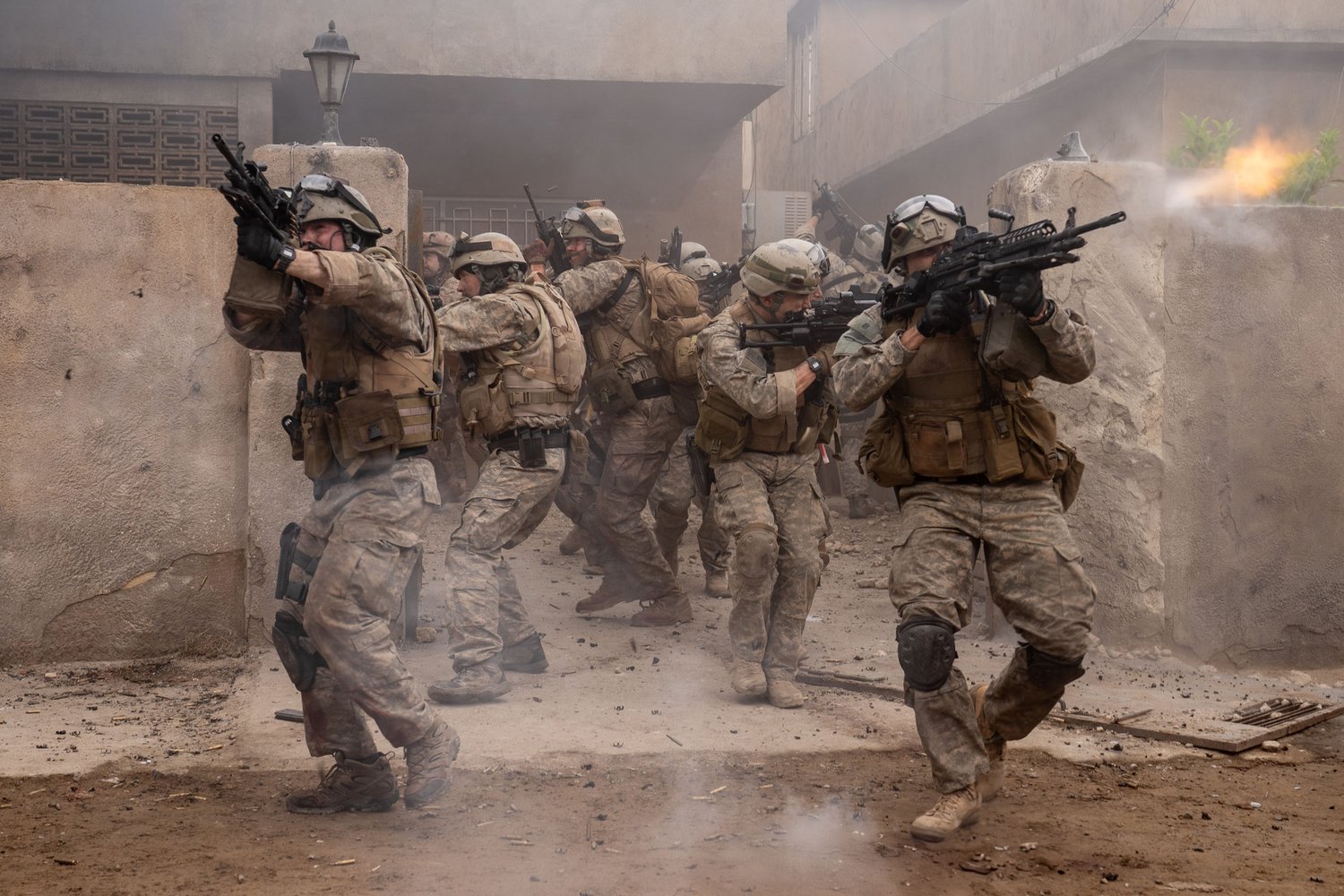Images courtesy of A24 Films
WARFARE– 4 STARS
Following a quick pre-credits scene of burly servicemen surrounding a small television roaring over the hot, lithe bodies of an energetic aerobics video, Warfare hits its datestamp of November 19, 2006 and the chicanery ends. Soldiers are shown armed to the teeth in full gear moving in a pair of formation lines silently up a residential Iraqi street in the darkness of a pre-dawn morning. They work with methodical precision and synchronized patience where, temporarily, you cannot picture them being the same lusty men introduced mere minutes earlier.
And then, for a hot second, one of the men in the lines imitates one of the aerobic dance moves to yuk it up. We laugh as the audience, but none of his comrades can fully laugh because of the necessary stealth. Nevertheless, you can tell smiles are beaming across a few faces under the helmets and night vision goggle visors. These men are that tight and comfortable as a unit. That right there, buyer beware, is the lightest moment in Warfare. From there on, risk takes over and it’s as serious as a heart attack.
What follows in Warfare unfurls in real-time to actual events witnessed by co-director Ray Mendoza, who was there as a JTAC communicator (positioned as the lead of the film played by up-and-coming actor D’Pharaoh Woon-A-Tai of TV’s Reservation Dogs). Mendoza’s team of Navy SEALs is taking a house placement for support of nearby U.S. Marine forces. Reconnaissance drones and satellite coverage provide intel, air support, and another view for the audience scooting closer to the edge of their seats. They are on sniper detail to observe the local opposition and make sure they do not impede the Marines’ activity. The point man with a scope to his eye and a trigger behind his finger is Elliot Miller (Cosmo Jarvis, currently seen in The Alto Knights).
Instead of moving against the Marines, the local Iraqis probe, organize, and eventually attack the SEAL position from the neighboring streets and rooftops with grenades and flurries of gunfire. With their position compromised, a pair of Bradley Fighting Vehicles are called to extract them. When a large IED strikes the vehicles during the exit, bodies are shattered and the shit hits the fan. What takes over is the titular combat, all taking place in an innocent Iraqi family’s home with them still there detained in a downstairs bedroom.
LESSON #1: CHANGING PLANS IN AND EMOTIONS COMBAT SITUATIONS– One amazing detail about Mendoza’s reenactment of Warfare is that those SEALs never fired a shot out of that house until they were fired upon. Now with casualties, the plans change as an observational mission shifts into a harrowing rescue one. Emotions are jolted as well. What started in stalking silence is now thick with the painful wails of mangled servicemen, including Miller and the upcoming Fantastic Four: First Steps star Joseph Quinn’s petty officer Sam. Pressure turns into pain and dominance to danger. Panic threatens previous preparedness. Survival is now the main function of all decisions being made.
LESSON #2: WHAT DOESN’T BREAK IN THESE TYPE OF MEN– Despite being outnumbered and pinned down, what doesn’t break among these top-flight operatives in Warfare is courage, trust, action, commitment, teamwork, and code. As the situation worsens, Dopesick and Guardians of the Galaxy Vol. 3 supporting player Will Poulter and May December Critics Choice Award winner Charles Melton emerge as the two key officers in charge ensuring that their vaunted precision is maintained and lives are saved. The wide array of teamwork on display is downright inspiring to watch, with no glorious glows of assistive hero worship.
Ray Mendoza, manning the director’s chair alongside the revered Alex Garland of Ex Machina and Civil War after a long Hollywood career as a technical advisor in action films, is here to not let any fluff get by him. Flanked by his own technical advisor Brian Philpot (Civil War), debuting military advisor Chappel Tim, and stunt coordinator Giedrius Nagys (Abigail), the acting ensemble of Warfare look, move, and speak their parts without a shred of showy grandstanding or indulgent monologues. The course of performances couldn’t be any leaner or more taut.
If the human precision isn’t impressive enough in Warfare, the production value work and rigorous filmmaking effort will galvanize and hammer that point home. Longtime steadicam specialist David J. Thompson (The Hunger Games: The Ballad of Songbirds and Snakes) earned his first full cinematographer credit on Warfare trapping the camera inside this central home. Thompson lets his framing and movement within the tight quarters pull the audience into the line of fire without the usual queasy shakes trying to depict confusion and disorientation. He doesn’t flinch because they don’t flinch, meaning we can’t either from our seats. This smooth imagery counts as another cool-headed trait of precision to match that of the determined and well-trained professionals on-screen.
Quite likely, the most memorable sensory adventure of enduring Warfare will be its enveloping environment of sound. The film is devoid of music and orchestrational score, allowing the hyper-tuned auditory design and the many merged sound effects from the production team led by supervising sound editors Ben Barker (Wonka) and Gravity Oscar winner Glenn Freemantle to stand out. Their harrowing panorama of acoustic mayhem puts viewers into the seemingly inescapable thick of it stronger than the already exceptional visual positioning.
When a movie like Warfare enters a concluded historical period, such as the Iraqi front of the War on Terror from nearly 20 years ago, some viewers will curiously require the film to have a “stance” on said war. Those captious people—looking down their noses with 20/20 hindsight to relitigate the past—are going to be disappointed with Ray Mendoza and Alex Garland, and falsely so. Retelling a very isolated operation in 95 minutes is not the place where side-choosing stances are going to be trumpeted like neighborhood political lawn signs before Election Day. People needing or looking for “stances” are watching the wrong movie. Projecting more than that is a mistake.
LESSON #3: MORE OFTEN THAN NOT, COMBAT IS APOLITICAL– The only stance that mattered in Warfare was the one of readiness and posture demonstrated by the Navy SEALs. They were there to follow orders and fulfill a mission requiring operational focus. When that was thwarted, the objective shifted to rescue and evacuation. Some soldiers are dead and others are on the floor, bleeding out. At that point, politics don’t matter. They never did. The agenda is to get the fuck out and get your men home. That’s it. Unlike Garland’s dystopian Civil War thriller a year ago—which took rightful flak for being grayly apolitical with its tremendously larger scope—being apolitical here for Warfare is the correct stance.
Even with all that said, there may still be ruffled people who will then ask why Warfare was even made if it doesn’t have traditional character arcs, an agenda, a stance, or “something to say” about the history. Ray Mendoza answered that best at the film’s premiere:
“I wanted to make it (Warfare) for Elliott. He doesn’t recall what happened. Over the years he’s asked a lot of questions. I’ve been in this industry for 15 years now, and it’s kind of a goal, a journey, for me to acquire all the tools and skills I needed along the way to make it.”
Partnering with an established filmmaker like Alex Garland filled in the rest of the tools and skills. Even from his perspective as an accomplished artist and storyteller, he too doubled down on the emphasis for accuracy stating:
“What films usually do is they find a way to dramatize, and that sometimes means romanticizing combat and conflict and to be inaccurate. We tried to strip all of that out and present war in this instance, as it was. That was our sole intention.”
LESSON #4: THE HONORABLE VICTORY OF ACCURACY– Romanticism and dramatization certainly have their places in the empathy engine of cinema and entertainment. Yet, there’s something to be said for taking those same artistic powers and putting them towards an extra level of accuracy and legitimacy. In that regard, the cast and crew of Warfare can stand tall presenting trueness for their real-life subjects, many of which are shown in the closing credits with blurred or redacted faces next to their matching actors because they are susceptible or classified targets still in the dangerous thick of their military careers. Even that realization during the post-film exhale brings one more jaw-dropping pause to Warfare. Making a film in this way is a hell of an honor to extend as a creator, which means seeing and appreciating the finished work counts as another honor.
LOGO DESIGNED BY MEENTS ILLUSTRATED (#1294)



